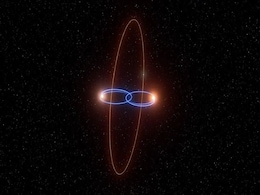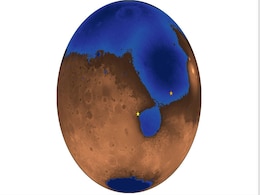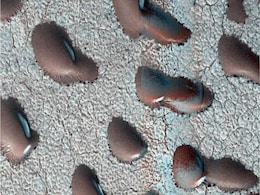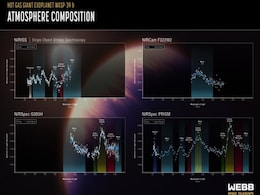Planetary Formation
- All
- News
-

Bizzare 'Failed Star' Planet Orbiting Double Star System in Milky Way Discovered by Researchers
- Thursday April 17, 2025
- Written by Gadgets 360 Staff
Astronomers have discovered an exoplanet 90 degrees tilted around a special pair of eclipsing brown dwarfs. This uncommon "polar planet" challenges accepted wisdom on planet creation by presenting new insights on the dynamics of binary stars and the range of Milky Way planetary orbits.
-
 www.gadgets360.com
www.gadgets360.com
-

JWST Captures Unseen Details of Exoplanets in HR 8799 and 51 Eridani Systems
- Thursday April 3, 2025
- Written by Gadgets 360 Staff
The James Webb Space Telescope (JWST) has captured groundbreaking images of exoplanets in the HR 8799 and 51 Eridani systems. By modifying its coronagraphs, astronomers allowed more starlight to pass through, revealing clearer planetary details. The study, published in The Astrophysical Journal Letters, highlights the first successful detection of ...
-
 www.gadgets360.com
www.gadgets360.com
-

3D Mapping Reveals 52-Foot Megaripples from Chicxulub Asteroid in Louisiana
- Thursday March 13, 2025
- Written by Gadgets 360 Staff
Massive megaripples, formed by the tsunami after the Chicxulub asteroid impact 66 million years ago, have been mapped deep beneath Louisiana using 3D seismic data. The formations, averaging 52 feet in height and spanning 900 square miles, offer new insights into the force of the ancient tsunami and its global impact. Scientists suggest these findin...
-
 www.gadgets360.com
www.gadgets360.com
-

Mysterious Planetary-Mass Objects May Form in Young Star System Clashes
- Wednesday March 12, 2025
- Written by Gadgets 360 Staff
Recent research challenges traditional views on planetary-mass objects, suggesting they may form through violent interactions between young star systems rather than standard planetary or stellar processes. Simulations indicate these clashes create dense gas filaments that evolve into free-floating objects, often in binary pairs. This discovery expl...
-
 www.gadgets360.com
www.gadgets360.com
-

Primordial Helium-3 May Be Locked in Earth’s Core, Study Finds
- Wednesday March 5, 2025
- Written by Gadgets 360 Staff
Helium-3, an isotope formed during the solar system's birth, may be trapped in Earth's core, a study suggests. Researchers at the University of Tokyo found that helium can mix with iron at extreme heat and pressure, allowing it to remain in Earth's solid core. This discovery could help determine how quickly the planet formed, with a rapid formation...
-
 www.gadgets360.com
www.gadgets360.com
-

Ancient Martian Ocean Shoreline Discovered Beneath Surface by Zhurong Rover
- Monday March 3, 2025
- Written by Gadgets 360 Staff
China's Zhurong rover has uncovered evidence of an ancient ocean on Mars, with ground-penetrating radar detecting a buried shoreline beneath the Utopia Basin. The rover’s scans revealed sloping sand layers similar to those found on Earth’s beaches, reinforcing theories of long-term water presence. Experts highlight that these formations are not...
-
 www.gadgets360.com
www.gadgets360.com
-

Hubble Captures Stunning Tarantula Nebula Image, Revealing Cosmic Dust and Star Formation
- Thursday February 27, 2025
- Written by Gadgets 360 Staff
A new image from the Hubble Space Telescope highlights the Tarantula Nebula’s complex structure, featuring dense cosmic dust clouds and vibrant star-forming regions. This nebula, located 160,000 light-years away, plays a vital role in understanding stellar evolution. The captured details offer insights into how cosmic dust contributes to star and...
-
 www.gadgets360.com
www.gadgets360.com
-

JWST Unveils HH 30’s Protoplanetary Disk, Showing Dust Grains and Jets
- Monday February 10, 2025
- Written by Gadgets 360 Staff
The James Webb Space Telescope has captured an extraordinary image of HH 30, a protoplanetary disk in the Taurus constellation. The dense dust disk conceals the central star, while bright jets extend outward, interacting with surrounding gas. Microscopic dust grains within the disk have been identified, playing a crucial role in planetary formation...
-
 www.gadgets360.com
www.gadgets360.com
-

High-Resolution Observations Provide New Insights into Brown Dwarf HD 206893 B
- Friday February 7, 2025
- Written by Gadgets 360 Staff
Astronomers have gained significant insights into brown dwarf HD 206893 B using high-resolution spectroscopy. The study, led by UCSD's Ben Sappey, reveals the object's mass, temperature, and formation details, contributing to brown dwarf research. Located 133 light-years away, HD 206893 B's position within a debris disk invites future investigation...
-
 www.gadgets360.com
www.gadgets360.com
-

SPHEREx Space Telescope to Map Cosmos in Infrared Light, Launching in February 2025
- Tuesday February 4, 2025
- Written by Gadgets 360 Staff
Set to launch in February 2025, NASA’s SPHEREx mission will provide a comprehensive map of the universe in infrared light. The telescope will examine 450 million galaxies and 100 million stars, shedding light on the universe’s formation, early conditions after the Big Bang, and the presence of water in planetary systems. SPHEREx will survey the...
-
 www.gadgets360.com
www.gadgets360.com
-

New Research Sheds Light on Iron’s Role in Earth’s Core Dynamics
- Thursday January 23, 2025
- Written by Gadgets 360 Staff
Cutting-edge research using ultrafast X-ray absorption spectroscopy has revealed the structural and thermal behaviour of iron under extreme conditions mimicking Earth’s core. Findings show a hexagonal close-packed (hcp) structure at 240 GPa and 5,345 K, challenging prior theories favouring a body-centred cubic (bcc) form. The study provides criti...
-
 www.gadgets360.com
www.gadgets360.com
-

Mars Satellite Images Reveal Giant 'Kidney Beans,' Sparking Hints of Water and Life
- Thursday January 16, 2025
- Written by Gadgets 360 Staff
NASA's Mars Reconnaissance Orbiter captured images of frozen sand dunes in Mars' northern hemisphere, revealing unique formations halted by carbon dioxide frost during winter. Unlike Earth's desert dunes, which shift with wind, these Martian dunes remain stationary until spring thaw releases their icy grip. Scientists study these features to unders...
-
 www.gadgets360.com
www.gadgets360.com
-

Astronomers Discover Water and Carbon Dioxide in WASP-166 b's Atmosphere
- Saturday January 11, 2025
- Written by Gadgets 360 Staff
Astronomers have detected water and carbon dioxide in the atmosphere of WASP-166 b, a hot super-Neptune exoplanet. Using data from the James Webb Space Telescope (JWST), the findings also noted ammonia in smaller quantities. WASP-166 b, located 368 light-years away, is a massive planet that orbits its star every 5.44 days, with a temperature of 1,2...
-
 www.gadgets360.com
www.gadgets360.com
-

'Kiss And Capture': Study Explains How Pluto's Largest Moon Was Formed
- Tuesday January 7, 2025
- Science | Edited by Nikhil Pandey
A new study suggests Pluto's largest moon, Charon, may have formed through a unique "kiss and capture" event billions of years ago.
-
 www.ndtv.com
www.ndtv.com
-

New "Kiss-and-Capture" Theory Explains Pluto's Formation of Largest Moon, Charon
- Wednesday January 8, 2025
- Written by Gadgets 360 Staff
A new theory proposes that Pluto’s largest moon, Charon, was formed billions of years ago through a rare "kiss-and-capture" collision in the Kuiper Belt. This process involves two icy bodies briefly merging and then separating, leaving Charon in a stable orbit around Pluto. Unlike traditional collision models, this event challenges previous theor...
-
 www.gadgets360.com
www.gadgets360.com
-

Bizzare 'Failed Star' Planet Orbiting Double Star System in Milky Way Discovered by Researchers
- Thursday April 17, 2025
- Written by Gadgets 360 Staff
Astronomers have discovered an exoplanet 90 degrees tilted around a special pair of eclipsing brown dwarfs. This uncommon "polar planet" challenges accepted wisdom on planet creation by presenting new insights on the dynamics of binary stars and the range of Milky Way planetary orbits.
-
 www.gadgets360.com
www.gadgets360.com
-

JWST Captures Unseen Details of Exoplanets in HR 8799 and 51 Eridani Systems
- Thursday April 3, 2025
- Written by Gadgets 360 Staff
The James Webb Space Telescope (JWST) has captured groundbreaking images of exoplanets in the HR 8799 and 51 Eridani systems. By modifying its coronagraphs, astronomers allowed more starlight to pass through, revealing clearer planetary details. The study, published in The Astrophysical Journal Letters, highlights the first successful detection of ...
-
 www.gadgets360.com
www.gadgets360.com
-

3D Mapping Reveals 52-Foot Megaripples from Chicxulub Asteroid in Louisiana
- Thursday March 13, 2025
- Written by Gadgets 360 Staff
Massive megaripples, formed by the tsunami after the Chicxulub asteroid impact 66 million years ago, have been mapped deep beneath Louisiana using 3D seismic data. The formations, averaging 52 feet in height and spanning 900 square miles, offer new insights into the force of the ancient tsunami and its global impact. Scientists suggest these findin...
-
 www.gadgets360.com
www.gadgets360.com
-

Mysterious Planetary-Mass Objects May Form in Young Star System Clashes
- Wednesday March 12, 2025
- Written by Gadgets 360 Staff
Recent research challenges traditional views on planetary-mass objects, suggesting they may form through violent interactions between young star systems rather than standard planetary or stellar processes. Simulations indicate these clashes create dense gas filaments that evolve into free-floating objects, often in binary pairs. This discovery expl...
-
 www.gadgets360.com
www.gadgets360.com
-

Primordial Helium-3 May Be Locked in Earth’s Core, Study Finds
- Wednesday March 5, 2025
- Written by Gadgets 360 Staff
Helium-3, an isotope formed during the solar system's birth, may be trapped in Earth's core, a study suggests. Researchers at the University of Tokyo found that helium can mix with iron at extreme heat and pressure, allowing it to remain in Earth's solid core. This discovery could help determine how quickly the planet formed, with a rapid formation...
-
 www.gadgets360.com
www.gadgets360.com
-

Ancient Martian Ocean Shoreline Discovered Beneath Surface by Zhurong Rover
- Monday March 3, 2025
- Written by Gadgets 360 Staff
China's Zhurong rover has uncovered evidence of an ancient ocean on Mars, with ground-penetrating radar detecting a buried shoreline beneath the Utopia Basin. The rover’s scans revealed sloping sand layers similar to those found on Earth’s beaches, reinforcing theories of long-term water presence. Experts highlight that these formations are not...
-
 www.gadgets360.com
www.gadgets360.com
-

Hubble Captures Stunning Tarantula Nebula Image, Revealing Cosmic Dust and Star Formation
- Thursday February 27, 2025
- Written by Gadgets 360 Staff
A new image from the Hubble Space Telescope highlights the Tarantula Nebula’s complex structure, featuring dense cosmic dust clouds and vibrant star-forming regions. This nebula, located 160,000 light-years away, plays a vital role in understanding stellar evolution. The captured details offer insights into how cosmic dust contributes to star and...
-
 www.gadgets360.com
www.gadgets360.com
-

JWST Unveils HH 30’s Protoplanetary Disk, Showing Dust Grains and Jets
- Monday February 10, 2025
- Written by Gadgets 360 Staff
The James Webb Space Telescope has captured an extraordinary image of HH 30, a protoplanetary disk in the Taurus constellation. The dense dust disk conceals the central star, while bright jets extend outward, interacting with surrounding gas. Microscopic dust grains within the disk have been identified, playing a crucial role in planetary formation...
-
 www.gadgets360.com
www.gadgets360.com
-

High-Resolution Observations Provide New Insights into Brown Dwarf HD 206893 B
- Friday February 7, 2025
- Written by Gadgets 360 Staff
Astronomers have gained significant insights into brown dwarf HD 206893 B using high-resolution spectroscopy. The study, led by UCSD's Ben Sappey, reveals the object's mass, temperature, and formation details, contributing to brown dwarf research. Located 133 light-years away, HD 206893 B's position within a debris disk invites future investigation...
-
 www.gadgets360.com
www.gadgets360.com
-

SPHEREx Space Telescope to Map Cosmos in Infrared Light, Launching in February 2025
- Tuesday February 4, 2025
- Written by Gadgets 360 Staff
Set to launch in February 2025, NASA’s SPHEREx mission will provide a comprehensive map of the universe in infrared light. The telescope will examine 450 million galaxies and 100 million stars, shedding light on the universe’s formation, early conditions after the Big Bang, and the presence of water in planetary systems. SPHEREx will survey the...
-
 www.gadgets360.com
www.gadgets360.com
-

New Research Sheds Light on Iron’s Role in Earth’s Core Dynamics
- Thursday January 23, 2025
- Written by Gadgets 360 Staff
Cutting-edge research using ultrafast X-ray absorption spectroscopy has revealed the structural and thermal behaviour of iron under extreme conditions mimicking Earth’s core. Findings show a hexagonal close-packed (hcp) structure at 240 GPa and 5,345 K, challenging prior theories favouring a body-centred cubic (bcc) form. The study provides criti...
-
 www.gadgets360.com
www.gadgets360.com
-

Mars Satellite Images Reveal Giant 'Kidney Beans,' Sparking Hints of Water and Life
- Thursday January 16, 2025
- Written by Gadgets 360 Staff
NASA's Mars Reconnaissance Orbiter captured images of frozen sand dunes in Mars' northern hemisphere, revealing unique formations halted by carbon dioxide frost during winter. Unlike Earth's desert dunes, which shift with wind, these Martian dunes remain stationary until spring thaw releases their icy grip. Scientists study these features to unders...
-
 www.gadgets360.com
www.gadgets360.com
-

Astronomers Discover Water and Carbon Dioxide in WASP-166 b's Atmosphere
- Saturday January 11, 2025
- Written by Gadgets 360 Staff
Astronomers have detected water and carbon dioxide in the atmosphere of WASP-166 b, a hot super-Neptune exoplanet. Using data from the James Webb Space Telescope (JWST), the findings also noted ammonia in smaller quantities. WASP-166 b, located 368 light-years away, is a massive planet that orbits its star every 5.44 days, with a temperature of 1,2...
-
 www.gadgets360.com
www.gadgets360.com
-

'Kiss And Capture': Study Explains How Pluto's Largest Moon Was Formed
- Tuesday January 7, 2025
- Science | Edited by Nikhil Pandey
A new study suggests Pluto's largest moon, Charon, may have formed through a unique "kiss and capture" event billions of years ago.
-
 www.ndtv.com
www.ndtv.com
-

New "Kiss-and-Capture" Theory Explains Pluto's Formation of Largest Moon, Charon
- Wednesday January 8, 2025
- Written by Gadgets 360 Staff
A new theory proposes that Pluto’s largest moon, Charon, was formed billions of years ago through a rare "kiss-and-capture" collision in the Kuiper Belt. This process involves two icy bodies briefly merging and then separating, leaving Charon in a stable orbit around Pluto. Unlike traditional collision models, this event challenges previous theor...
-
 www.gadgets360.com
www.gadgets360.com
















